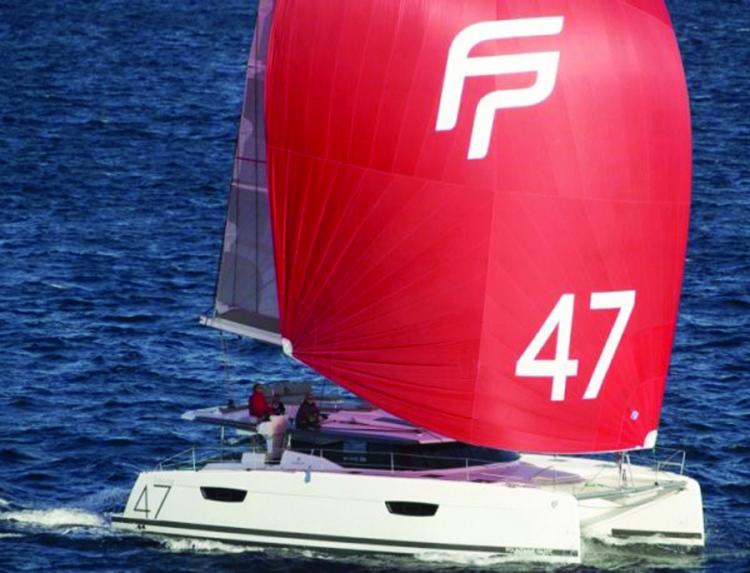Fountaine Pajot Saona 47
An abbreviated history:
Fountaine Pajot was established in France in 1976 by the French foursome Yves Pajot, Daniel Gvon, Remi Tritstan, and Jean-Francois Fountaine. Building concentration between the 1976 and 1981 appeared to be in competitive monohulls with a competitive multihull introduced in 1981. The first production cruising catamaran built by Fountaine Pajot was the Lousiane 37 introduced in 1983.

The business structure remained consistent until going public in 2008, followed by a merger with Dufour Yachts in 2018. According to its website, the company has designed and introduced more than 40 models of both sailboats and powerboats since 1976. As of 2016 the company boasted having built 2700 catamarans, making them the most prolific builder of catamarans in the world. Fountaine Pajot has two building facilities: in La Rochelle and Aigrefeuille, France.
Fountaine Pajot Saona 47, introduced in 2017, is defined as a midsized cat in the Fountaine Pajot lineup and reportedly the last size range to benefit from a redesign of the entire product line.
As with many late-model watercraft these days, the exterior lines have been changing to a noticeably more angular design with more freeboard and less of the curved surfaces noted in the earlier models. To increase interior space and headroom the F/P designers seem to have opted to utilize a more vertical approach in the hull designs. The increased freeboard has allowed for more headroom, creating a roomier and lighter feel in the interior, while still maintaining the relatively shallow draft.
The basic interior layout is similar to other catamarans, with the galley and saloon in the center and staterooms and heads lower in the port and starboard hulls. The variable in the Saona is in the options for the port hull configuration. The Saona is available in two models: the three-cabin “Maestro” owner’s version and the five-cabin charter version. The Maestro version uses the entire port hull as the owner’s space, with a large bunk aft (on the opposite side of the boat as the generator), connected to a sizeable lounge/office/sitting area and large ultra-modern head that utilizes most of the forward port hull bow area.
Machinery:
The engines on the vessel I was inspecting were the 60-hp Volvo D-2 engines coupled to Volvo sail drives. While Volvo makes a quality durable product; in my opinion the service network has been slow to catch up to the increase in Volvo product that is currently in service. Some of the blame can be placed on the powerboat market and the almost overnight proliferation of large diesels running Volvo IPS drives that have been a game changer in the 40-plus-foot powerboat market (now changing to outboards, but that is a discussion for a different magazine). Fountaine Pajot shore power systems are built at the factory with European-compatible hardware. U.S.-sold boats routinely undergo significant renovation of the shore power electrical systems once they arrive in the states.
The generator is situated in the starboard engine compartment, only a few feet away from the starboard aft guest room (maybe a helpful hint when “randomly” choosing your berth on the next charter trip?).
The generator and engines are located in dedicated port and starboard engine compartments that are accessed via deck hatches at the stern. Access to the engines is above average with ample space to work. There is no need for service personnel to enter the boat interior for routine or major engine work. Engine options for the Saona are the standard equipment 50-hp Volvos with an option for twin 60-hp Volvos.
Considerations and observations:
Volvo D-2 engines have had issues with control module failures; although easy to replace, replacing the control module erases the engine hours. Mechanical meters are recommended as backups. Accurate engine hour information is critical to potential buyers and for determining factory recommended service requirements.
It has been suggested that the engine compartments could be better insulated to diffuse engine and generator noise into the vessel interior.
As a general statement about catamarans, marinas and haul-out facilities are not as accessible as those available to monohulls. With that said, with a 25-plus-foot beam we were still able to get hauled for survey at the wide lift at Port Annapolis Marina, with a whole three inches to spare. Anything wider requires a day trip north to Georgetown Yacht Basin.
Availability:
Being a recently introduced model, not a whole lot of used product is currently available. As of September 1, there were three Saonas available in the U.S. starting at $877,000.
Specifications:
L.O.A.: 45.7’
BEAM: 25.3
DRAFT: 3.9
DISPLACEMENT: 29,000 lbs.
Designer: Berret-Racoupeau
Builder: Fountain Pajot
About the Author: Capt. Tarn Kelsey owns and operates Kelsey Marine Survey in Annapolis.




